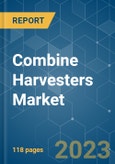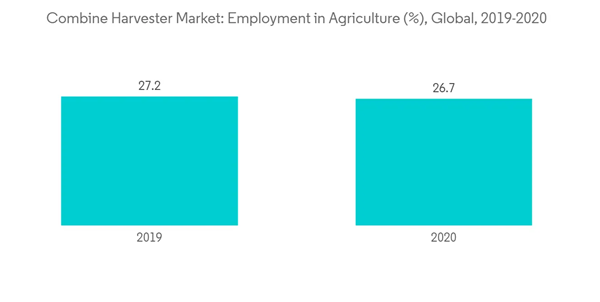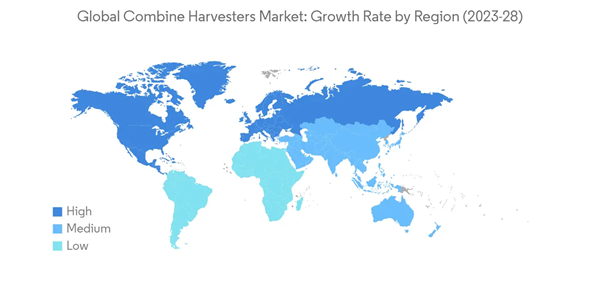The combined harvesters market is projected to register a CAGR of 3.7% during the forecast period.
According to the Indian Council of Food and Agriculture, the percentage of agriculture workers in India is estimated to decline by 25.7% in 2050, leading to the increasing demand for agricultural equipment, including combined harvesters. Farm mechanization saves time and labor, cuts down crop production costs in the long run, reduces post-harvest losses, and boosts crop output and farm income.
The United States holds a major share of North America's combined harvesters market. Agriculture is a major occupation in the United States, where the mechanization of farming is considered an important reason for increased productivity, sales, and export. The technological advancements are directed toward the use of combined harvesters in agricultural fields.
According to the Association of Equipment Manufacturers, the sale of self-propelled combined harvesters in the United States saw a gain of 15.8% in 2022 compared to the previous year. In January 2021, 194 self-propelled combined harvesters were sold in the country, while it was 200 units in January 2022. A double-digit growth across North America for combined harvesters indicates the greater demand for the same.
This product will be delivered within 2 business days.
Key Highlights
- Increasing farm mechanization is one of the most important reasons behind the growth of the combined harvesters market. Farm mechanization saves time and labor, cuts down crop production costs in the long run, reduces post-harvest losses, and boosts crop output and farm income. Steady growth was observed in manually operated tools, animal-operated implements, and equipment operated by mechanical and electrical power sources.
- Agricultural systems worldwide have undergone changes in the cropping system, the type of power sources used, and the application of inputs to achieve a high level of productivity. The concerns about increasing the productivity of farms with declining labor availability are mainly driving the market. The favorable credit policies toward machinery purchases adopted by the government and other institutions, coupled with the ability to increase farm productivity, are driving the market's growth.
- Asian countries like India, China, and Japan are urging farmers to adopt the latest technologies to enhance productivity. China and Japan are moving toward autonomous farms in the upcoming years. Hence, the major players in the country are investing in developing advanced combine harvesters.
Combine Harvesters Market Trends
Labor Shortage and Rising Cost of Farm Labor
The factors expected to augment the demand for combined harvesters are growth in the urban population and industrialization, which led to a shortage in farm labor, thus pushing the farmers to employ machinery for harvesting. Farmers are increasingly adopting agricultural mechanization as a substitute for manual labor since they are a more cost-effective, easily available, and more efficient means of agricultural operation.According to the Indian Council of Food and Agriculture, the percentage of agriculture workers in India is estimated to decline by 25.7% in 2050, leading to the increasing demand for agricultural equipment, including combined harvesters. Farm mechanization saves time and labor, cuts down crop production costs in the long run, reduces post-harvest losses, and boosts crop output and farm income.
North America Dominates the Market
The scarcity of labor and the rising labor costs in North America, coupled with the need to replace old machinery with new ones, are encouraging the region to adopt the new technology and enhance the productivity and efficiency of the crops grown in North America. The erratic climate conditions in the region are driving the market for combined harvesters due to their high operational efficiency.The United States holds a major share of North America's combined harvesters market. Agriculture is a major occupation in the United States, where the mechanization of farming is considered an important reason for increased productivity, sales, and export. The technological advancements are directed toward the use of combined harvesters in agricultural fields.
According to the Association of Equipment Manufacturers, the sale of self-propelled combined harvesters in the United States saw a gain of 15.8% in 2022 compared to the previous year. In January 2021, 194 self-propelled combined harvesters were sold in the country, while it was 200 units in January 2022. A double-digit growth across North America for combined harvesters indicates the greater demand for the same.
Combine Harvesters Industry Overview
The combined harvesters market is consolidated with key players such as CLAAS, John Deere, Yanmar Co. Ltd, and Kubota Agricultural Machinery. These companies are partnering with other companies and expanding their production capacities to cater to the growing demand for innovative combined harvester products. These companies are heavily investing in developing new products and collaborating with and acquiring other companies to increase their market shares while strengthening their R&D activities.Additional Benefits:
- The market estimate (ME) sheet in Excel format
- 3 months of analyst support
This product will be delivered within 2 business days.
Table of Contents
1 INTRODUCTION
4 MARKET DYNAMICS
5 MARKET SEGMENTATION
6 COMPETITIVE LANDSCAPE
Companies Mentioned (Partial List)
A selection of companies mentioned in this report includes, but is not limited to:
- Tractors and Farm Equipment Limited (TAFE)
- Claas KGaA GmbH
- Mahindra & Mahindra Ltd
- Kubota Agricultural Machinery
- Deere & Company
- Yanmar Co. Ltd
- Massey Ferguson (AGCO Corporation)
- Iseki & Co. Ltd
- CNH Industries NV
- SDF
- Renault Sonalika International
- PREET GROUP
Methodology

LOADING...










